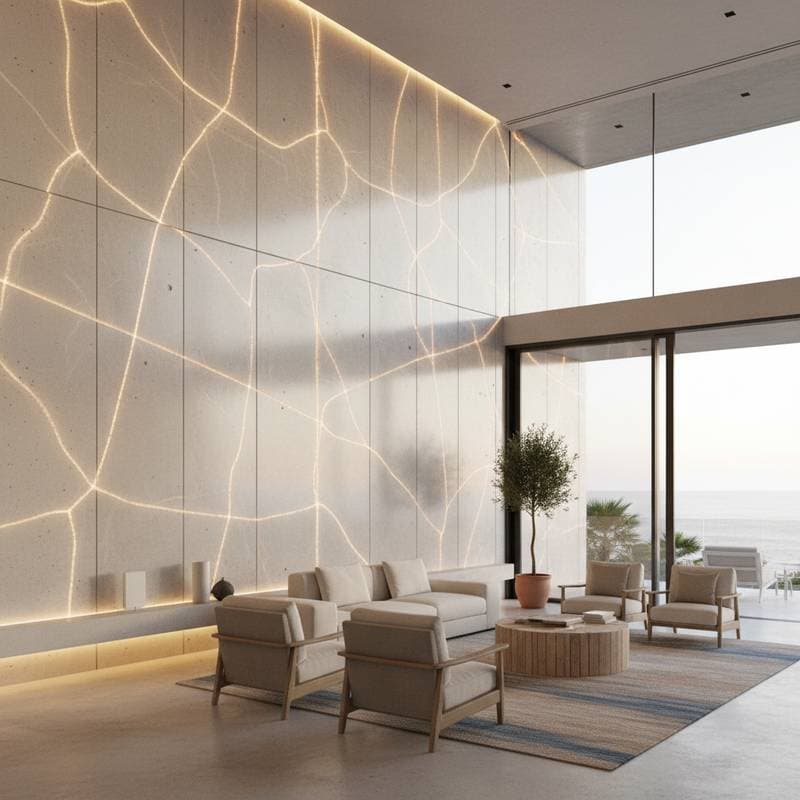Translucent Concrete Walls Light Up Coastal Homes
Translucent concrete walls redefine natural light integration in coastal homes. These materials merge robust construction with aesthetic innovation, permitting daylight to penetrate solid barriers without compromising privacy or longevity. Coastal residents increasingly adopt this technology for walls, dividers, and facades, converting standard areas into radiant features that mirror the ocean's gentle cadence.
What Makes Translucent Concrete Unique
Translucent concrete, also known as light-transmitting concrete, integrates conventional cement aggregates with optical fibers or resin conduits. These elements channel light across the material's thickness, yielding a gentle, even radiance. The outcome resembles ordinary concrete in load-bearing capacity yet introduces a dynamic luminosity that evolves with daily light shifts.
How It Works
Optical fibers, numbering in the thousands per panel, weave through the concrete matrix to convey light from exterior to interior surfaces. Incident sunlight or positioned artificial sources travel via these fibers, generating diffused lighting. Designers calibrate the fiber-to-cement proportion to fine-tune translucency levels, balancing illumination with visual seclusion.
Key advantages include:
- Natural daylighting that minimizes thermal buildup from direct sun exposure
- Maintained privacy through scattered light patterns
- Superior resilience against coastal environmental stresses
- Versatility for load-bearing and ornamental applications
Cost and Installation Overview
Pricing for translucent concrete depends on manufacturer specifications, customization extent, and fiber concentration. Expect costs between $250 and $400 per square foot, encompassing materials, fabrication, and on-site assembly. Although pricier than conventional options, the enhanced aesthetics and reduced energy demands frequently offset the expense over time.
| Project Type | Cost Range (per sq. ft.) | Typical Use | Estimated ROI |
|---|---|---|---|
| Interior feature wall | $250 - $300 | Living room, hallway | 65% |
| Exterior facade | $300 - $400 | Entryway, patio wall | 70% |
| Custom panels | $350 - $450 | Bathrooms, stairwells | 60% |
These figures account for structural reinforcement, surface finishing, and fiber embedding. Projects involving patterned motifs or tinted variants incur additional charges, yet produce distinctive, bespoke elements.
Why Coastal Homes Benefit from Light-Transmitting Walls
Seaside properties contend with salt-laden air, elevated moisture, and gale-force winds. Translucent concrete endures these rigors effectively, while its inherent luminescence amplifies indoor serenity.
Benefits for coastal living:
- Energy savings: Diminished reliance on electric lights during daylight hours
- Weather resistance: Limited degradation from salt or fading
- Privacy: Indirect glow obstructs clear views
- Sustainability: Compatibility with photovoltaic or LED augmentation
Property owners in littoral zones often retrofit select exterior segments or internal partitions with this material. The synergy of ambient coastal illumination and the panels' soft emanation fosters a calm, contemporary vibe.
Design Ideas for Translucent Concrete in Coastal Homes
Translucent concrete unlocks diverse architectural expressions. Professionals employ it to fuse daylight with sleek silhouettes, elevating inert surfaces to interactive components.
Popular applications include:
- Accent walls: Radiant separators in foyers or lounges
- Bathroom dividers: Secluded yet softly lit enclosures
- Outdoor seating walls: Backlit boundaries for gardens or pools
- Staircase panels: Gently illuminated treads or flanks
- Facade highlights: Embedded sections that activate at twilight
In marine settings, juxtaposing translucent concrete against reclaimed timber, transparent glazing, or quarried rock amplifies naturalistic tones. This assembly of radiance, tactility, and specular play cultivates a restorative milieu attuned to marine panoramas.
Factors Influencing Cost and Performance
Multiple variables shape the expense and efficacy of translucent concrete installations:
- Fiber density: Higher concentrations boost luminosity at elevated prices
- Panel thickness: Greater depth enhances stability while marginally reducing transmittance
- Installation complexity: Non-standard geometries or integrated illuminants escalate workmanship fees
- Environmental exposure: Maritime factors necessitate extra protective coatings
- Integration with lighting systems: Supplementary LEDs amplify evening visibility
Strategic selection harmonizes these elements to realize intended effects within fiscal limits.
Planning Tips for Homeowners
Prospective projects warrant input from civil engineers and illumination specialists for seamless incorporation. Heed these strategies:
- Define the purpose of each wall or panel early in the design process.
- Request samples to assess light intensity and hue variations.
- Combine natural and artificial light for balanced illumination.
- Budget for maintenance, such as cleaning and sealant reapplication.
- Work with experienced installers familiar with fiber-optic concrete systems.
Thorough preparation and expert collaboration mitigate subsequent modifications and expenses.
FAQs About Translucent Concrete Walls
How strong is translucent concrete compared to regular concrete?
It possesses compressive strength comparable to standard concrete, qualifying it for structural and non-structural roles alike.
Can it be used outdoors in coastal climates?
Yes. With appropriate sealing and upkeep, it repels corrosion and water ingress effectively.
Does translucent concrete provide insulation?
Its thermal properties align with those of regular concrete, though light conveyance remains its foremost attribute.
Living with Light and Texture
Translucent concrete walls introduce vitality to coastal residences. They unite the reliability of established building practices with light's ephemeral quality, yielding spaces that convey stability and brilliance. For those pursuing forward-thinking elegance and eco-conscious utility, this medium delivers equilibrium between structure and sensation.


